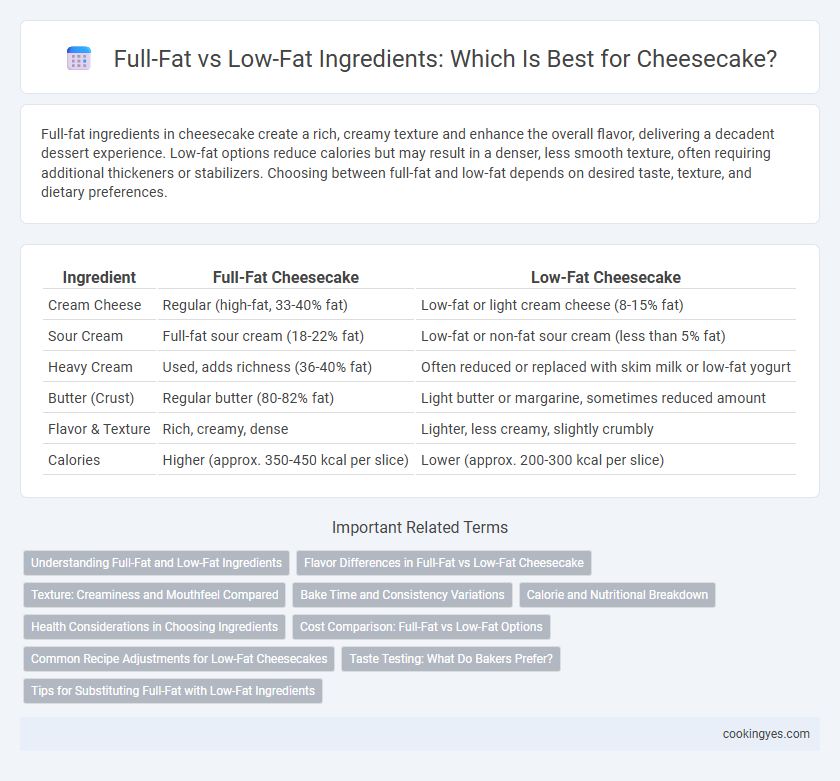Full-fat ingredients in cheesecake create a rich, creamy texture and enhance the overall flavor, delivering a decadent dessert experience. Low-fat options reduce calories but may result in a denser, less smooth texture, often requiring additional thickeners or stabilizers. Choosing between full-fat and low-fat depends on desired taste, texture, and dietary preferences.
Table of Comparison
| Ingredient | Full-Fat Cheesecake | Low-Fat Cheesecake |
|---|---|---|
| Cream Cheese | Regular (high-fat, 33-40% fat) | Low-fat or light cream cheese (8-15% fat) |
| Sour Cream | Full-fat sour cream (18-22% fat) | Low-fat or non-fat sour cream (less than 5% fat) |
| Heavy Cream | Used, adds richness (36-40% fat) | Often reduced or replaced with skim milk or low-fat yogurt |
| Butter (Crust) | Regular butter (80-82% fat) | Light butter or margarine, sometimes reduced amount |
| Flavor & Texture | Rich, creamy, dense | Lighter, less creamy, slightly crumbly |
| Calories | Higher (approx. 350-450 kcal per slice) | Lower (approx. 200-300 kcal per slice) |
Understanding Full-Fat and Low-Fat Ingredients
Full-fat ingredients in cheesecake, such as cream cheese and heavy cream, provide a rich, creamy texture and intense flavor due to their higher fat content, typically around 35-40%. Low-fat alternatives contain reduced fat levels, often below 10%, resulting in a lighter texture and less pronounced taste but lower calories. Understanding the fat content difference is crucial for achieving the desired consistency and flavor profile in cheesecake recipes.
Flavor Differences in Full-Fat vs Low-Fat Cheesecake
Full-fat cheesecake boasts a rich, creamy texture and intense flavor due to higher butterfat content in cream cheese and sour cream, enhancing the dessert's smoothness and mouthfeel. Low-fat cheesecake often has a lighter texture but can taste less indulgent and slightly tangier, as reduced fat alters the balance of moisture and richness. Fat composition directly influences flavor depth and creaminess, making full-fat versions the preferred choice for classic cheesecake enthusiasts.
Texture: Creaminess and Mouthfeel Compared
Full-fat ingredients in cheesecake contribute to a richer creaminess and smoother mouthfeel, creating a dense and luxurious texture. Low-fat alternatives often result in a lighter, less silky consistency, which can lead to a slightly grainier or drier sensation. The fat content directly influences the smooth, velvety quality characteristic of classic cheesecakes.
Bake Time and Consistency Variations
Full-fat cream cheese in cheesecake results in a richer, denser texture and typically requires a slightly longer bake time to set properly without cracking. Low-fat cream cheese introduces more moisture, often leading to a lighter, less creamy consistency and may cook faster, increasing the risk of overbaking or a grainy texture. Adjusting oven temperature and closely monitoring bake time are essential to achieve the desired firmness and smoothness based on the fat content of the ingredients.
Calorie and Nutritional Breakdown
Full-fat cheesecake ingredients typically contain around 350-450 calories per slice, with 25-35 grams of fat, including high levels of saturated fat, while low-fat versions reduce calorie content to approximately 200-300 calories and cut fat to 10-15 grams by using reduced-fat cream cheese or yogurt. Full-fat options provide more fat-soluble vitamins like vitamins A and D, whereas low-fat cheesecakes generally have higher protein content due to added dairy substitutes but may sacrifice creaminess and texture. Choosing between full-fat and low-fat ingredients significantly impacts the cheesecake's calorie density and macronutrient profile, influencing overall nutritional balance.
Health Considerations in Choosing Ingredients
Full-fat ingredients in cheesecake contribute to a richer texture and creamier flavor but contain higher levels of saturated fats, which may impact heart health if consumed excessively. Low-fat alternatives reduce calorie and fat intake, supporting weight management and cardiovascular wellness, but can compromise the smoothness and mouthfeel of the final dessert. Selecting ingredients based on dietary goals requires balancing taste preferences with health considerations such as cholesterol levels and saturated fat content.
Cost Comparison: Full-Fat vs Low-Fat Options
Full-fat cheesecake ingredients typically cost more due to higher butter and cream cheese content, impacting overall recipe expenses. Low-fat options often reduce costs by using reduced-fat dairy products and substituting some cream with milk or yogurt. Budget-conscious bakers can save money with low-fat ingredients, but should consider flavor and texture differences in the final cheesecake.
Common Recipe Adjustments for Low-Fat Cheesecakes
Low-fat cheesecakes commonly replace full-fat cream cheese with reduced-fat or fat-free versions, which can alter texture and creaminess, requiring additional ingredients like Greek yogurt or silken tofu to enhance moisture and smoothness. Sugar substitutes or increases in natural sweeteners often compensate for flavor loss caused by lower fat content. Modifying baking time and adding thickeners such as cornstarch or gelatin helps maintain structure and prevent cracking traditionally achieved by full-fat ingredients.
Taste Testing: What Do Bakers Prefer?
Full-fat ingredients in cheesecake deliver a rich, creamy texture and intense flavor that most bakers favor for authentic taste and mouthfeel. Low-fat alternatives often result in a denser, less flavorful dessert, leading many professionals to avoid them despite health trends. Taste tests consistently show that full-fat cream cheese and heavy cream produce superior results in both texture and flavor appreciation among expert bakers.
Tips for Substituting Full-Fat with Low-Fat Ingredients
When substituting full-fat ingredients with low-fat alternatives in cheesecake recipes, use low-fat cream cheese and yogurt to maintain creaminess without excess calories. Incorporate a small amount of cornstarch or gelatin to improve texture and prevent sogginess often caused by reduced fat content. Adjust baking time slightly to avoid dryness, ensuring the cheesecake remains smooth and rich despite lower fat levels.
Full-fat vs low-fat for cheesecake ingredients Infographic

 cookingyes.com
cookingyes.com